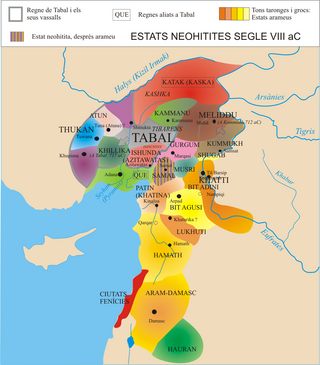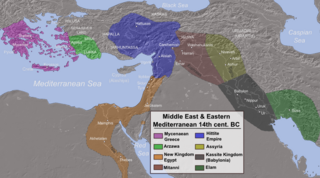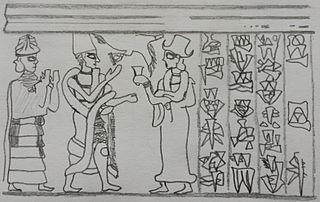
The Hittites were an Anatolian people who played an important role in establishing first a kingdom in Kussara, then the Kanesh or Nesha kingdom, and next an empire centered on Hattusa in north-central Anatolia. This empire reached its height during the mid-14th century BC under Šuppiluliuma I, when it encompassed an area that included most of Anatolia as well as parts of the northern Levant and Upper Mesopotamia.
Tunna, also Dunna or Atuna, was an ancient Anatolian city. In classical antiquity Tunna was known as Tynna. Today it is known as Porsuk Hüyük or Zeyve Höyük.

Mitanni, c. 1550–1260 BC, earlier called Ḫabigalbat in old Babylonian texts, c. 1600 BC; Hanigalbat or Hani-Rabbat in Assyrian records, or Naharin in Egyptian texts, was a Hurrian-speaking state in northern Syria and southeast Anatolia. Since no histories or royal annals/chronicles have yet been found in its excavated sites, knowledge about Mitanni is sparse compared to the other powers in the area, and dependent on what its neighbours commented in their texts.

Yamhad was an ancient Semitic kingdom centered on Ḥalab (Aleppo), Syria. The kingdom emerged at the end of the 19th century BC, and was ruled by the Yamhadite dynasty kings, who counted on both military and diplomacy to expand their realm. From the beginning of its establishment, the kingdom withstood the aggressions of its neighbors Mari, Qatna and Assyria, and was turned into the most powerful Syrian kingdom of its era through the actions of its king Yarim-Lim I. By the middle of the 18th century BC, most of Syria minus the south came under the authority of Yamhad, either as a direct possession or through vassalage, and for nearly a century and a half, Yamhad dominated northern, northwestern and eastern Syria, and had influence over small kingdoms in Mesopotamia at the borders of Elam. The kingdom was eventually destroyed by the Hittites, then annexed by Mitanni in the 16th century BC.
Wilusa or Wilusiya was a Late Bronze Age city in western Anatolia known from references in fragmentary Hittite records. The city is notable for its identification with the archaeological site of Troy, and thus its potential connection to the legendary Trojan War.
Mursili II was a king of the Hittite Empire c. 1330–1295 BC or 1321–1295 BC.

Kussara (Kuššar) was a Middle Bronze Age kingdom in Anatolia. The kingdom, though apparently important at one time, is mostly remembered today as the origin of the dynasty that would form the Old Hittite Kingdom.
Kurunta was younger son of the early 13th century BC Hittite king Muwatalli II and cousin of Tudhaliya IV. Kurunta was thereby a Hittite prince and king of Tarhuntassa country. It has been suggested that he may have captured the Hittite capital for a very short time during the reign of the Hittite king Tuthaliya IV and declared himself a great king.

Cybistra or Kybistra, earlier known as Ḫubišna, was a town of ancient Cappadocia or Cilicia. Its site is located about 10km northeast of the modern town of Ereğli in Konya Province, Turkey. It was the capital of a Luwian-speaking Neo-Hittite kingdom in the 1st millennium BCE.
Kuzi-Teshub was a Neo-Hittite King of Carchemish, reigning in the early to mid-12th century BC, likely in 1180-1150 BC. He was the son of Talmi-Teshub, who was both the last viceroy of the Hittite Empire at Carchemish under Suppiluliuma II and a direct descendant of Suppiluliuma I. Kuzi-Teshub reigned in Carchemish as well as in the later Neo-Hittite city of Melid.
Huzziya II was a king of the Hittites. He was killed by Muwatalli I, who seized the throne and was possibly the Gal Mesedi of the royal bodyguard.
The gal mesedi was a Hittite military and administrative title literally meaning "chief of the royal bodyguards". He was in charge of the Mesedi, the personal bodyguard of the Hittite king. It is considered to be one of the most important and prestigious posts of the Hittite Kingdom.
The gal dubsar was a Hittite administrative title literally meaning "chief of the scribes". It is considered to be one of the most important and prestigious posts of the Hittite Empire as the gal dubsar was the head of the government.

Attarsiya was a 15th–14th century BCE military leader of Ahhiya. In the Hittite archives of circa 1400 BCE, he is described as a "man of Ahhiya", a country identified with the Achaeans and Mycenaean Greece. The campaigns of Attarsiya, as well as his conflict with the Hittite vassal, Madduwatta, represent the first recorded Mycenaean Greek military activity on the Anatolian mainland, as well as the first conflict between Achaeans and Hittites. He finally withdrew from Anatolia after Hittite intervention, but later launched a campaign against Alashiya (Cyprus).
Hassum was a Hurrian city-state, located in southern Turkey most probably on the Euphrates river north of Carchemish.

The Yamhad dynasty was an ancient Amorite royal family founded in c. 1810 BC by Sumu-Epuh of Yamhad who had his capital in the city of Aleppo. Started as a local dynasty, the family expanded its influence through the actions of its energetic ruler Yarim-Lim I who turned it into the most influential family in the Levant through both diplomatic and military tools. At its height the dynasty controlled most of northern Syria and the modern Turkish province of Hatay with a cadet branch ruling in the city of Alalakh.

Gurgum was a Neo-Hittite state in Anatolia, known from the 10th to the 7th century BC. Its name is given as Gurgum in Assyrian sources, while its native name seems to have been Kurkuma for the reason that the capital of Gurgum—Marqas in Assyrian sources —was named "the Kurkumaean city" in local Hieroglyphic Luwian inscriptions.

The military nature of Mycenaean Greece in the Late Bronze Age is evident by the numerous weapons unearthed, warrior and combat representations in contemporary art, as well as by the preserved Greek Linear B records. The Mycenaeans invested in the development of military infrastructure with military production and logistics being supervised directly from the palatial centres. This militaristic ethos inspired later Ancient Greek tradition, and especially Homer's epics, which are focused on the heroic nature of the Mycenaean-era warrior élite.
The House of Suhi was a dynasty of rulers of Carchemish. The members of this dynasty are best known to us through Hieroglyphic Luwian sources. Only one member of the house of Suhi is specifically mentioned in Assyrian sources. The House of Suhi was followed by a dynasty known as the House of Astiruwa.
Hartapu was an Anatolian king in the 8th century BCE. He is known from Hieroglyphic Luwian inscriptions from Kizildağ, Mount Karadağ, Burunkaya near Aksaray, and most recently Türkmen-Karahöyük, site of a monumental stele in which he claimed victory over the kingdom of Phrygia, ruled around that time by King Midas.